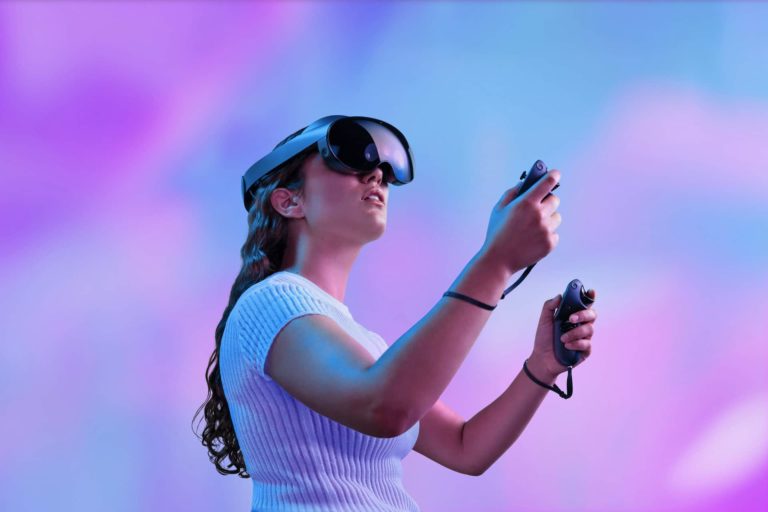
In case you haven’t heard, this week was all about Meta Quest Pro. The long-awaited and heavily-leaked device was at the center of a news barrage from Wednesday’s Meta Connect event. Other updates include Microsoft gaming & productivity integrations, and avatar legs.
Through all this, coverage from the tech press has been mixed, as it often goes for a contentious company like Meta. The schadenfreude lingers from Meta’s past sins, though it does deserve credit from VR (and AR) proponents for essentially bankrolling and accelerating the sector.
Wherever you stand on Meta, a reportorial compulsion runs deep in the tech press towards “if it bleeds, it leads.” So rebuke is piled on heavily, regardless of what’s announced. But even with that compulsion, Quest Pro reviews are mostly positive – a testament to the device.
So for this week’s XR Talks, we’re highlighting the best video reviews, which are sprinkled throughout the narrative below. And because we can’t help ourselves (a compulsion in the analyst corps) we’ve sprinkled in some of our own analysis on Quest Pro’s positioning and strategy.
Common Chorus
First, to get the specs out of the way, the $1,499 Quest Pro has an 1800×1920 per-eye LCD display. It employs the new Qualcomm XR2+ chip (50 percent more powerful), 72h and 90hz frame rates, 12 GB of ram, 256 GB of storage, color passthrough cameras, and a 1-2 hour battery.
A common chorus from reviewers was the device’s comfort. Though it’s heavier than Quest 2, it has smarter weight balance, including a Hololens 2-like rear counterbalance. Pancake lenses also reduce the device’s front profile by 40 percent versus Quest 2’s front-heavy fresnels.
Another standout is Quest Pro’s controllers. It ditched the outside-in tracking system of the Quest 2, which fell apart when controllers drifted behind your back or otherwise out of view from the headset’s front-facing cameras. They now have outside-in tracking for autonomous movement.
The controllers also have more precise haptic engines, which come in handy for Quest Pro’s target enterprise use cases. These include things like training, collaborative design, or productivity. The latter makes use of the controllers’ double duty as a stylus when flipped around.
Future Generations
Speaking of tracking, face tracking is a big selling point for Quest Pro. Inward-facing cameras track users’ facial movement to render expressions – a key component of social interaction, and a missing puzzle piece for VR today (though Altspace VR has devised some clever hacks).
This social-expression piece is a big priority for Meta, as one of its biggest VR endpoints is to simulate realistic communication for human interaction in VR. That includes remote collaboration and productivity, which for now are the biggest target use cases for Quest Pro.
But there’s one issue….face tracking is only valuable if everyone in the room (or at least two people interacting in VR) has it. This raises the issue of feature parity, which is challenged if Quest Pro falls short of network effect – a likely near-term outcome given the price point.
But that’s not to say that advanced face tracking isn’t strategically sound. Meta is testing the waters at the high end of its device spectrum, and will likely migrate this and other features down-market in future generations. Translation: we could see face tracking in next year’s Quest 3.
Digital Elements
Saving the biggest update for last, Quest Pro’s headline is its color passthrough cameras that enable true mixed reality. Cameras render the world beyond the headset in greater definition and scale so that users can operate in their surroundings while interacting with digital elements.
This brings Quest Pro into AR territory. Indeed, one flavor of head-worn AR is passthrough camera-based, versus optical waveguides that project graphics on see-through lenses. Passthrough AR has a few advantages including greater color, contrast, and control of the scene.
However, one downside of passthrough AR is device bulk, given that it requires more of a VR form factor. Counteracting this was a core design target for Quest Pro, which can be seen in the ergonomics noted above, as well as its frame that prioritizes peripheral vision.
Though it comes with magnetic side blinders that slip in for more contained VR experiences, the default is to see your periphery. This is so users’ passthrough field of view ends where their peripheral vision begins, thus achieving a continuous and natural view of one’s surroundings.
Bridge to AR
These unobstructed views are where the “Pro” in Quest Pro comes in. Again, it’s targeting enterprise and productivity use cases that require you to move around and grab things as needed. That could be picking up a controller/stylus if you’re a designer, or grabbing records if you’re a DJ.
Altogether this lands Quest Pro somewhere between Quest 2 and Hololens 2. This is a mixed reality proposition that’s mostly been limited to higher-end devices like Varjo’s XR-3. And though it doesn’t match Varjo’s graphics and processing, Quest Pro’s price tag is about $5000 lower.
Similarly, Quest Pro’s passthrough capabilities make it more competitive with Magic Leap 2 and Hololens 2 than any VR device. And it’s less than half the price of those units. This means Meta has once again disrupted an XR segment by undercutting it in a meaningful way.
But the larger point is that Quest Pro is a bridge to AR. Meta’s spatial computing ambitions span AR and VR, but most of its focus has been on the latter. It’s separately building AR glasses with EssilorLuxottica, but Quest Pro represents another track. It will attack from many angles.






